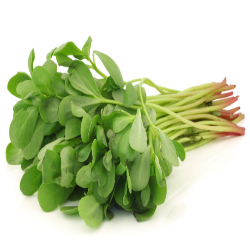Purslane Nutrition facts
Purslane

Soft, succulent purslane leaves have more omega-3 fatty acids than in some of the fish oils. If you are a vegetarian and pledge to avoid all forms of animal products, then here is the answer! Go for this healthy dark-green leafy vegetable and soon you will forget fish!
Botanically, this herbaceous leafy vegetable belongs to the family of Portulacaceae and scientifically known as Portulaca oleracea.
Other common names in place for this green leafy are pursley, pigweed, or verdolaga.
| Nutrition Principle | Nutrition Value | Percentage of RDA |
|---|---|---|
| Principle | ||
| Energy | 16 Kcal | 1.5% |
| Carbohydrates | 3.4 g | 3% |
| Protein | 1.30 g | 2% |
| Total Fat | 0.1 g | 0.5% |
| Cholesterol | 0 mg | 0% |
| Vitamins | ||
| Folates | 12 µg | 3% |
| Niacin | 0.480 mg | 3% |
| Pantothenic acid | 0.036 mg | 1% |
| Pyridoxine | 0.073 mg | 5.5% |
| Riboflavin | 0.112 mg | 8.5% |
| Thiamin | 0.047 mg | 4% |
| Vitamin A | 1320 IU | 44% |
| Vitamin C | 21 mg | 35% |
| Electrolytes | ||
| Sodium | 45 mg | 3% |
| Potassium | 494 mg | 10.5% |
| Minerals | ||
| Calcium | 65 mg | 6.5% |
| Copper | 0.113 mg | 12.5% |
| Iron | 1.99 mg | 25% |
| Magnesium | 68 mg | 17% |
| Manganese | 0.303 mg | 13% |
| Phosphorus | 44 mg | 6% |
| Selenium | 0.9 µg | 2% |
| Zinc | 0.17 mg | 1.5% |